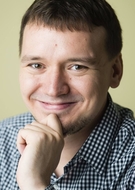Ivan Sablin

Education: PhD History, University of Heidelberg, MA Global History, University of Heidelberg, MA International Relations, Saint Petersburgh State University, BA International Relations, Saint Petersburgh State University
Ivan Sablin leads the Research Group “Entangled Parliamentarisms: Constitutional Practices in Russia, Ukraine, China and Mongolia, 1905–2005,” sponsored by the European Research Council (ERC) at the University of Heidelberg.
When did you first develop an interest in Slavic, East European and Eurasian Studies? 
Ironically, I became interested in Eurasian Studies, specifically in Siberia and the Russian Far East, after I came to Germany for my MA. The history of Asiatic Russia is missing from the high school curriculum in Russia, but when I started reading about Siberia in Heidelberg, I discovered a whole sub-universe of global history with immense diversity, rich indigenous cultures, and deep transboundary connections – between Buryatia and Mongolia; between Chukotka and Alaska; between the Russian Far East, Korea, China, and Japan.
What support have you received throughout your career (from ASEEES / other societies / federal support / etc.) that has allowed you to advance your scholarship?
Apart from my mother’s investment into my education, a high school exchange program funded by the US Department of State proved formative for my future career. While in the US, I developed interests in transnational and transcultural matters and became a proponent of societal openness. For my career proper, the funding of the German Research Foundation (DFG) and the European Research Council (ERC) were especially important. The latter allowed me to start my own research group. I am also grateful for the support of the Higher School of Economics (HSE) in Saint Petersburg.
What is your current research/work project?
My most recent book focused on the history of the Far Eastern Republic, which occupied the expanse between Lake Baikal and the Pacific coast in 1920–1922. The republic had a diverse population of Russians, Koreans, Buryat-Mongols, Chinese, Ukrainians, and other groups. This year I launched a bigger project at the University of Heidelberg, the research group “Entangled Parliamentarisms: Constitutional Practices in Russia, Ukraine, China, and Mongolia, 1905–2005.” The group currently has four members exploring the interconnected history of Eurasian parliaments through individual cases. I focus on Russian and the Soviet legislatures and supervise PhD theses on Ukraine and Mongolia.
What does your ASEEES membership mean to you? How has your involvement with ASEEES helped to further your career?
The ASEEES is by far the most representative association globally and for me it proved a fantastic forum for meeting new colleagues. During the previous conventions, I participated in panels on Siberian and Russian imperial history at large. Given the relatively small number of experts on Siberian Buddhism and their dispersal throughout the world, it was the ASEEES convention which brought us together for the first time and then again, a year later.
What do you believe is the most important impact ASEEES has on the field?
The ASEEES plays a crucial role in the circulation of knowledge and fosters the dialogue between otherwise distanced specific subfields. The meetings and the exchange then set the foundation for new projects.
Besides your professional work, what other interests and/or hobbies do you enjoy?
My interests are somewhat fluid. Recently I became interested in Sci-Fi literature. Music is among my more persistent interests. I especially like opera (my favorite ones are Mussorgsky’s Boris Godunov and Mozart’s The Marriage of Figaro) and metal. We are usually going to the opera with my wife or my mother. My wife and I also enjoy underground gigs. Recently, we discovered synthwave – a genre appealing to non-existent music from the 80s. I guess, this feature also makes it a professional interest.
